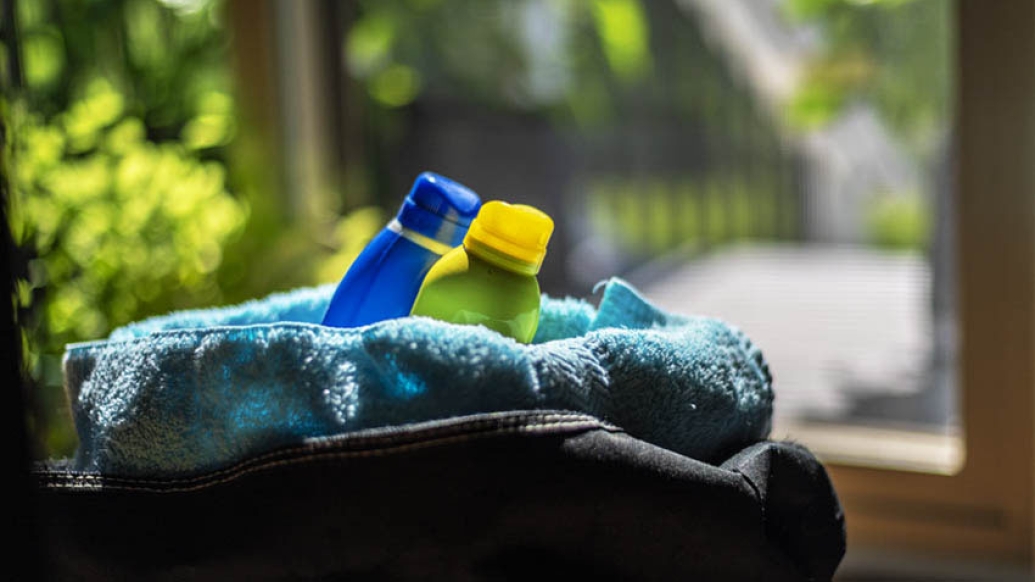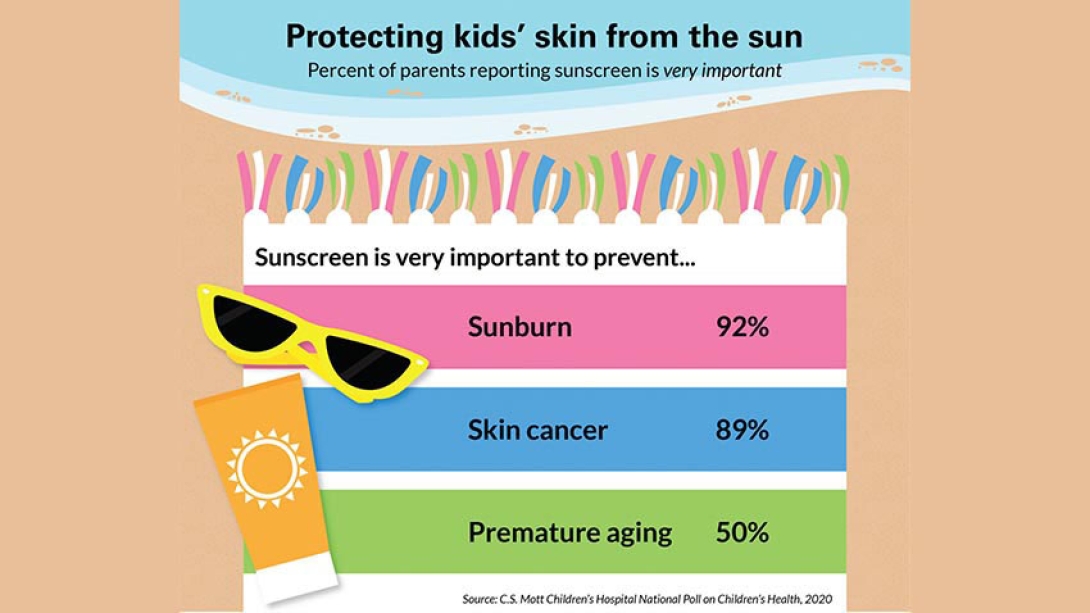Some parents may not provide adequate sun protection for their children, a national poll suggests. A Mott pediatrician offers top sun safety tips to follow.
12:30 PM
Author |

Maybe it's a cloudy day and you don't think the sun rays are so harmful. Or maybe you lose track of time.
Or, it could simply be that you're avoiding the inevitable battle of asking your children to get out of the pool and dry off for that second coat of sunscreen.
LISTEN UP: Add the new Michigan Medicine News Break to your Alexa-enabled device, or subscribe to our daily updates on iTunes, Google Play and Stitcher.
While most parents understand the importance of using sunscreen, many may still not be taking all of the right steps to properly protect children's skin – especially when it comes to reapplying – according to the C.S. Mott Children's Hospital National Poll on Children's Health at Michigan Medicine.
But protecting little ones from the heat is crucial to preventing painful sunburns and UV radiation that can cause skin cancer and premature wrinkles and aging.
Mott pediatrician Sarah DeHaan, M.D., offers top sun safety tips and discusses common mistakes to avoid because of these misconceptions:
1. All sunscreen is created equal
DeHaan says parents should look for two criteria when choosing sunscreen for their child: a high enough SPF and a "broad spectrum" label.
She recommends a minimum SPF that's between 15 and 50. There isn't any evidence that anything beyond 50 provides additional benefits.
And a higher SPF doesn't mean you don't need to re-apply as often.
"High SPF labels can sometimes be misleading," she says. "People think these products protect them for longer durations. That doesn't tend to be true because most people, especially kids, are often sweating and wiping off sunscreen. The higher number isn't as important as the frequency of applying."
She also cautions parents who use sunscreen spray to ensure children are getting even coverage on their skin and not missing any areas.
"Broad spectrum" sunscreens are also important for protecting against both types of damaging UV radiation, including ultraviolet B (UVB) and ultraviolet A (UVA) rays.
For parents who want more details on specific sunscreens, DeHaan recommends looking them up online through the nonprofit Environmental Working Group. The EWG publishes a list of sunscreens they believe use safer ingredients both for the environment and for kids that are less likely to cause allergic skin reactions.
Probably the No.1 issue is not reapplying sunscreen frequently enough. We can't just apply once and be done for the day.Sarah DeHaan, M.D.
2. Sunscreen is just for sunny days
One in four parents surveyed in the Mott Poll don't re-apply sunscreen on their child on a cloudy day
While clouds do reduce some harmful UV rays, they don't block all of them. UVA rays can penetrate clouds and reach below the water's surface.
They can also bounce back from reflective surfaces like sand, water, snow or concrete, making sun exposure a risk year round. So while there may be less risk of a sunburn on cloudy – or even snowy days – that's not a reason to skip sunscreen.
MORE FROM MICHIGAN: Sign up for our weekly newsletter
"Parents may not take the same precautions when it's cloudy as they would on a bright sunny day," DeHaan says. "But it's important to remember that children are still exposed to the sun's rays and need the same sun protection."
3. Sunscreen can be waterproof
Some families may overestimate the value of a "water resistant" label, DeHaan says.
Sunscreens marked water resistant are required to state whether the sunscreen remains effective for 40 minutes or 80 minutes when swimming or sweating.
But slathering on sunscreen just once before a child dashes off to play at the beach or in the pool isn't enough.
"No sunscreens are waterproof. They all eventually wash off," DeHaan says. "It's important to re-apply even more frequently than usual if a child is spending a lot of time in the water."

4. Dark skin protects you from sun damage
While people with darker skin may have some built-in skin protection because of a pigment known as melanin that filters more UV radiation, this natural protection only goes so far.
"People with fair skin may burn more quickly and easily than those with darker skin tones, but no one is immune to the potential harms of sun exposure," DeHaan says.
"We don't want parents to have a false sense of security that prevents them from protecting their families in the sun. Everyone should wear sunscreen."
While sun-induced skin cancer may be rarer in people with dark skin, some studies suggest that when Black people are diagnosed with skin cancer, the disease may be in an advanced stage and more difficult to treat. Black people also have a 69% five-year survival rate compared to 93% in whites, according to the American Cancer Society.
Poor awareness of skin cancer risk and delayed care often play a role.
5. Sunscreen always has you covered
Sunscreen should actually be the last resort for sun protection, DeHaan says. The first: avoiding the sun from the get-go.
Parents should encourage kids to "play around the sun" and limit sun exposure during the peak intensity hours between 10 a.m. and 4 p.m. They could also stay in the shade and use protective clothing, such as lightweight clothes that cover the arms and legs and a wide-brimmed hat that shades the face and back of the neck. Sunglasses with UV protection should also be used to protect children's eyes.
These measures are especially important for babies six months and under who should stay out of direct sunlight, DeHaan says. She recommends using hats, stroller canopies and shaded areas. For small exposed areas like a baby's face or the backs of their hands, a gentle, mineral-based sunscreen (SPF 15 or higher) may be used.
When sunscreen is necessary, parents should remember to re-apply every two hours and more often if children are swimming.
"Probably the No.1 issue is not reapplying sunscreen frequently enough," DeHaan says. "We can't just apply once and be done for the day."
"Sun-induced health problems are preventable," she adds. "Taking the right steps to protect our kids from the sun has both short term and long term benefits."

Explore a variety of health care news & stories by visiting the Health Lab home page for more articles.

Department of Communication at Michigan Medicine
Want top health & research news weekly? Sign up for Health Lab’s newsletters today!





